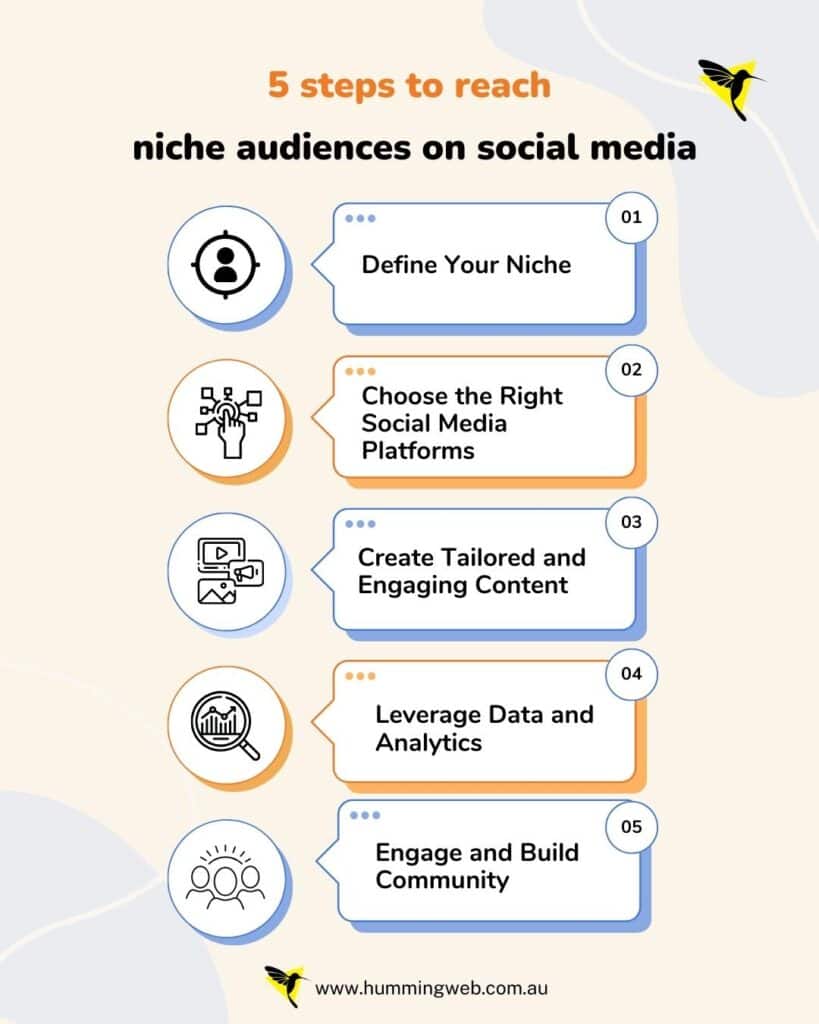In today’s digital age, where social media has become a prominent platform for marketing efforts, it’s crucial to understand the concept of niche audience targeting. Niche audience targeting involves tailoring your marketing strategies to resonate with a specific group of people who share common interests, needs, or characteristics. This article aims to delve into the significance of niche audience targeting on social media and explore effective ways to reach and engage with the right people within your niche.
Understanding Niche Audience

Before delving into niche audience targeting, it’s essential to define your niche. A niche refers to a distinct segment of the market that has specific needs or preferences. Understanding your niche audience involves identifying the demographics, interests, and behaviors of the individuals who are most likely to be interested in your product. By creating a well-defined audience persona, you can tailor your marketing campaigns to cater to the specific needs and preferences of your target audience within your niche.
The importance of niche targeting cannot be overstated. Targeting a niche audience allows you to focus your marketing efforts and resources on the right people, increasing the likelihood of generating leads and conversions. It enables you to build brand awareness and establish your presence within your niche, ultimately leading to stronger customer loyalty and retention.
Identifying niche market trends is crucial for successful niche audience targeting. By staying abreast of the latest trends and developments within your niche, you can adapt your marketing strategies to align with the evolving needs and preferences of your target audience. This proactive approach ensures that your marketing strategy remains relevant and impactful in a rapidly changing market landscape.
Reaching Your Target Audience
Optimizing social media ads is a key strategy for reaching and engaging with your niche audience. Leveraging the targeting options provided by social media platforms, such as demographic filters and interest-based targeting, allows you to tailor your ads to reach potential customers within your niche, thereby maximizing the impact of your marketing campaigns.
Utilizing hashtags effectively can significantly enhance your visibility and reach on social media platforms. By incorporating relevant and trending hashtags into your content, you can increase the discoverability of your posts within your specific market community, attracting the attention of potential customers who are actively searching for content related to your niche.
Engaging with influencers who have a strong presence within your niche can amplify your brand’s reach and credibility. Collaborating with influencers to promote your products enables you to tap into their established audience base and leverage their influence to effectively connect with your target audience on social media.
How can you use social media to reach niche audiences?

Step 1: Define Your Niche
Understanding and pinpointing your niche is the foundational step to successful social media targeting. A niche, in this context, refers to a distinct and specialized segment of the market that shares common interests, needs, or characteristics. Before diving into the dynamic world of social media, take the time to conduct comprehensive market research. Identify the specific traits, preferences, and pain points of your target audience. Ask yourself: What sets this group apart? What challenges do they face, and how can your product or service address those challenges uniquely?
For instance, if you’re in the fitness industry, your specific market might not just be “fitness enthusiasts” but could be more specific, such as “busy professionals seeking quick and effective at-home workouts.” This level of precision ensures that your social media efforts are tailored to a group with a genuine interest in what you offer.
To define your specific market effectively, look for patterns in your existing customer base, analyze competitors’ successes and failures, and consider conducting surveys or engaging in direct conversations with your audience. The clearer your understanding of your niche, the more targeted and resonant your social media strategies can become.
Step 2: Choose the Right Social Media Platforms
Once you’ve crystallized your niche, the next crucial step is selecting the most fitting social media platforms to engage with your audience. Each platform has its unique strengths and user demographics, so it’s essential to align your brand with the ones most frequented by your niche. Consider the nature of your content and the preferences of your target audience.
For example, if your specific market is visually oriented, platforms like Instagram or Pinterest may be more effective. If your audience engages in professional discussions or seeks informative content, platforms like LinkedIn or Twitter might be better suited. The key is not to spread yourself too thin across all platforms but to strategically concentrate your efforts where your audience is most active.
Moreover, think about cross-platform compatibility and how your content can be repurposed or tailored for different platforms. This approach ensures a cohesive brand presence while catering to the specific expectations of each platform.
In essence, choosing the right social media platforms is about understanding where your niche hangs out online, aligning your content with the platform’s strengths, and maximizing your brand’s visibility where it matters most.
Step 3: Create Tailored and Engaging Content
Now that you’ve identified your niche and selected the appropriate social media platforms, the next critical step is crafting content that resonates with your specific audience. Tailoring your content to your specific market ensures that your message is not only heard but enthusiastically received. Consider the unique preferences, interests, and challenges of your audience as you develop your content strategy.
Begin by leveraging the power of personalization. Speak directly to the concerns and aspirations of your specific market, using language and visuals that they can relate to. Whether it’s through storytelling, relatable anecdotes, or user-generated content, make sure your audience sees themselves reflected in your posts. For instance, if your niche is passionate about sustainability, showcase your eco-friendly initiatives or share user testimonials highlighting their positive experiences with your sustainable products.
Visual appeal is paramount in today’s social media landscape. Invest time in creating eye-catching graphics, videos, and other multimedia elements that align with your brand and resonate with your audience’s aesthetic preferences. Keep in mind that the most effective content is not just visually appealing but also emotionally engaging.
Lastly, be consistent in your messaging. Establish a recognizable tone and style that reflects your brand and connects with your specific market audience. Whether your approach is humorous, educational, or inspirational, maintaining a cohesive content identity builds trust and loyalty over time. In essence, the key to success in Step 3 is to create content that speaks directly to the hearts and minds of your specific market audience, fostering a genuine connection that goes beyond a simple transaction.
Step 4: Leverage Data and Analytics
Navigating the intricate world of social media requires more than intuition; it demands a strategic embrace of data analysis. Once your tailored content is live, it’s time to tap into the wealth of information available to refine and enhance your strategies. Social media analytics acts as your compass, providing insights into user behavior, content performance, and overall engagement.
Start by establishing clear key performance indicators (KPIs) that align with your business goals. Metrics like click-through rates, conversion rates, and audience demographics are instrumental in gauging the effectiveness of your efforts. Regularly delve into these metrics to uncover patterns and trends, identifying areas of success and those in need of refinement. For instance, if specific content types consistently garner more attention or certain posting times yield higher engagement, use this data to fine-tune your content calendar.
Platforms such as Facebook Insights and Instagram Analytics offer detailed data analysis on user interactions. Dive into these metrics to understand which posts resonate most with your specific market audience. By gleaning insights from the data, you can adjust your content strategy in real-time, optimizing for what works best.
Flexibility is crucial in the dynamic landscape of social media. If a particular approach proves successful, consider doubling down on it. Conversely, if certain tactics don’t yield the expected results, be prepared to pivot. The iterative process of analyzing data and refining strategies positions your social media efforts as agile and responsive to the evolving preferences of your niche audience.
Step 5: Engage and Build Community
With a defined niche, carefully selected platforms, tailored content, and data-backed strategies in place, the final step involves fostering a sense of community and actively engaging with your audience. Social media is not merely a broadcast channel; it’s a dynamic space for interaction and relationship-building.
Initiate two-way conversations with your audience by responding promptly to comments, messages, and mentions. Acknowledge and appreciate user-generated content, showcasing it as a testament to your community’s vitality. Encourage discussions, polls, and other interactive features to solicit input from your specific market, making them feel heard and valued.
Building a community extends beyond your brand to include the connections between your audience members. Facilitate these connections by creating spaces for collaboration and discussion. This could be through branded hashtags, themed challenges, or dedicated groups where your specific market can share experiences and insights related to your products.
Consistency is key to community engagement. Regularly schedule interactive sessions, live Q&A sessions, or behind-the-scenes glimpses to maintain an ongoing dialogue with your audience. By nurturing a sense of belonging and shared interest, you not only solidify your brand’s position within the niche but also encourage loyalty and advocacy.
Ultimately, the goal is to transform your social media presence into a thriving community where members feel a genuine connection with your brand and with each other. By actively engaging and building a community, you position your business as more than just a provider of products or services; you become a focal point for shared experiences and mutual support within your specific market.
Conclusion
In the ever-evolving landscape of social media, targeting a niche audience requires a strategic blend of precision and engagement. By defining your specific market, selecting the right platforms, crafting personalized content, and leveraging data, you’ve set the stage for success. However, the journey doesn’t end there. Actively engaging with your audience, fostering community, and staying agile based on analytics are the keys to sustained success. Social media isn’t just about numbers; it’s about building meaningful connections. As you navigate this digital terrain, remember that success lies not just in metrics but in the lasting impact you make on your specific market audience’s experiences and lives. Stay committed to understanding, adapting, and engaging, and your brand will thrive in the world of niche-focused social media.


